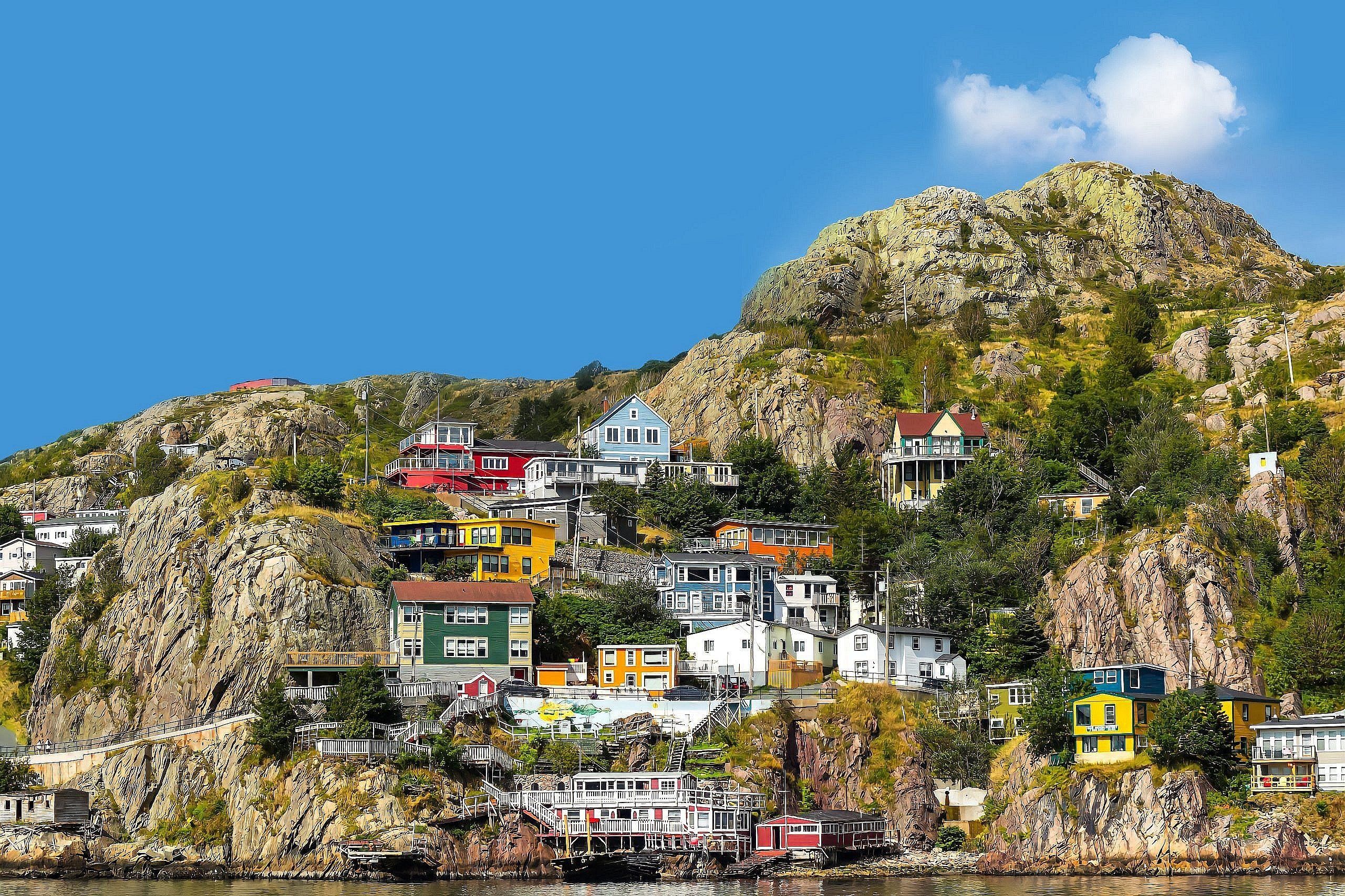The Great Escapes: 10 Places to Visit in Canada Right Now
Share
October 2, 2023
After a few years of (mostly) staying put, Canadians have a major case of wanderlust. And while the old travel standbys—Montreal, Vancouver, Banff, Niagara—are reliable for a reason, many people are looking for somewhere less touristy, less congested, less expensive. That’s where this list comes in. We polled our stable of writers across the country to tell us about their favourite hidden-gem destinations. And they delivered. The following pages contain a collection of inspired under-the-radar vacation spots: bustling small cities about to break big, outdoor adventures with puffins and bison, delicious and diverse food on both coasts, and ambitious, province-spanning road trips. It’s as much a travel guide as it is an intimate portrait of a Canada you rarely see.
WHITEHORSE, YUKON
The Northern Exposure
There are outdoor adventures, live music and Arctic char tacos under the midnight sun
BY RHIANNON RUSSELL
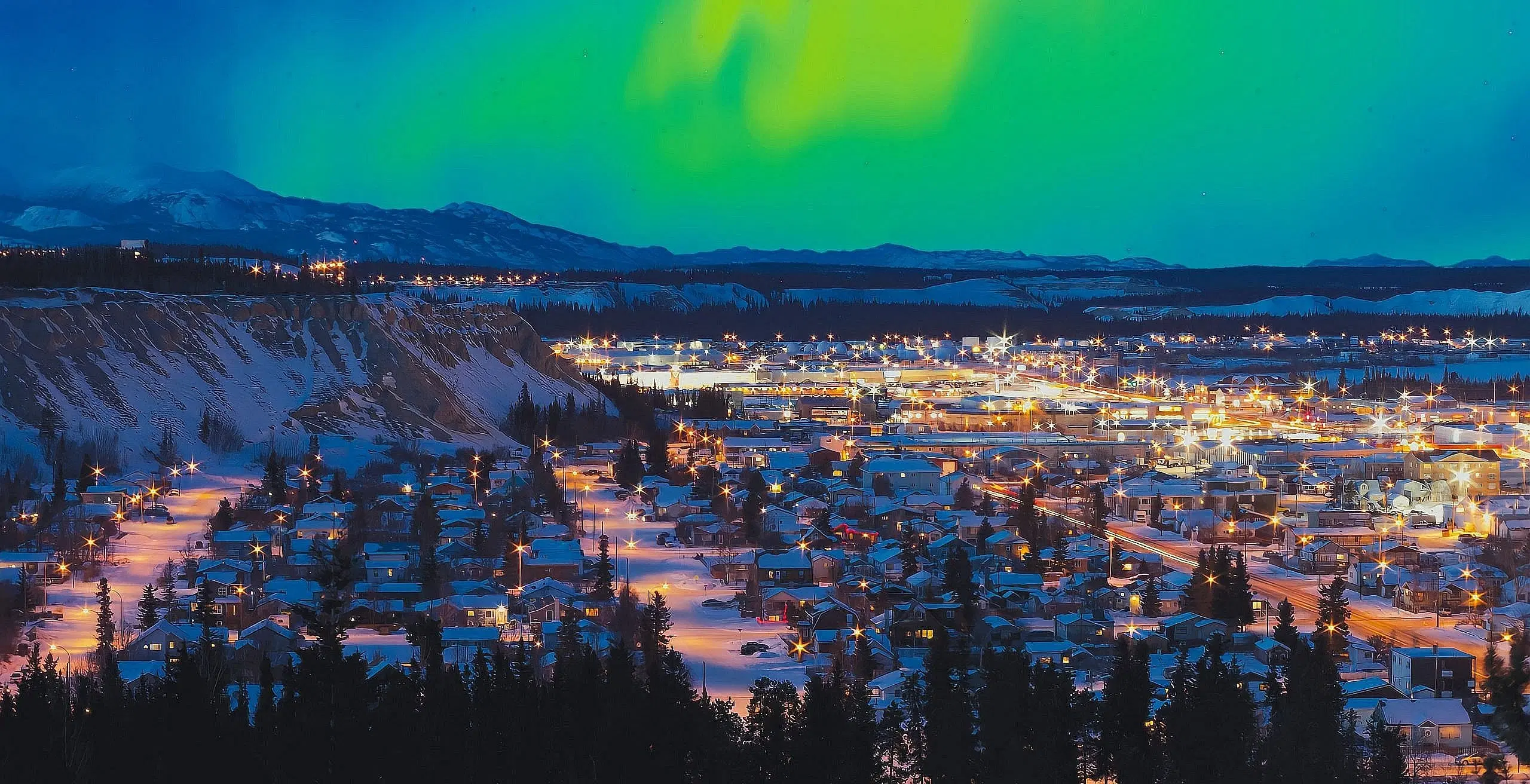
My first summer in Whitehorse, my eyes were wide open. Sunlight streamed through my bedroom window at 10 p.m. A bald eagle swooped above me as I ran along the Yukon River downtown. My roommate brought home a fish she’d caught that day and cooked it up for dinner in our kitchen. Everywhere I looked, mountains.
It was 2014, and I’d moved from Hamilton, Ontario, to Whitehorse for a job at the daily newspaper. I intended to stay a year. I’d gone to university in Toronto, and I loved the chaos of the big city; I didn’t hike, camp, or even much like spending time outdoors. Sometime that first summer, though, I told my mom over the phone, “I think I’m going to change, living here.” With a population of about 30,000 people, Whitehorse has a small-town feel. But as Yukon’s capital, it feels more cosmopolitan than you might expect. There’s a vibrant arts and culture scene, with galleries, performance venues and museums. My first summer, I went to a Nuit Blanche event under the midnight sun. For 12 hours—half of them sunlit—people wandered from installation to installation, admiring 3D projections of landscapes near the river, listening to live music from church pews, and watching breakdancing and live graffiti.
And in the 10 years I’ve lived here, a fleet of fantastic and eclectic new restaurants have opened. Wayfarer Oyster House offers fresh seafood inside a brewery, while Gather Café, connected to a glass-blowing studio, offers up tacos stuffed with locally farmed Arctic char. As for accommodations, the Raven Inn is a short walk from Main Street, and the Black Spruce offers Scandinavian-inspired luxury cabins, both catering to year-round tourists.
Yes, year-round. While the long, warm summer days offer endless opportunities for hiking, running and biking in the wilderness (Grey Mountain and Mount McIntyre are two gorgeous trail networks, located right in town), Whitehorse is alluring in winter too. The cold creates a thick ice fog that hangs over the Yukon River, and the darkness brings surreal pink skies at sunrise and sunset. Winter is the best time to visit Eclipse Nordic Hot Springs, an oasis north of the city that recently opened, where thick steam rises off the water, turning your eyelashes white with frost. And during the cold months, visitors take dogsledding and northern lights tours, while locals head out onto frozen lakes to fish on the ice, or hit the trails on fat bikes, snowshoes and cross-country skis.
Two First Nations women recently launched businesses that take visitors out on the land. In Pelly Crossing, a three-hour drive north of Whitehorse, Teri-Lee Isaac operates Tutchone Tours, providing river boat trips to historic Fort Selkirk, where the Hücha Hudän—better known today as the Selkirk First Nation—would meet with the coastal Tlingit for trade. Later, in the 1850s, Fort Selkirk became a Hudson’s Bay trading post. Dinjii Zhuh Adventures, meanwhile, based in Whitehorse, provides guided canoe trips throughout Yukon and the Northwest Territories. Owner Bobbi Rose Koe is Teetl’it Gwich’in, from Fort McPherson in the Northwest Territories.
A little over a year after I arrived in Yukon, I decided I needed a professional change, so I moved back to Ontario. Days before I left, I had three small mountains tattooed on my arm. The move home didn’t stick—I came back to Whitehorse for good in 2017. I missed people’s openness, the expressive skies, the proximity to wilderness (there are gorgeous forest trails a five-minute walk from my house). Here, you can step out your front door on a bitter-cold night and see the aurora dancing above you. You can hike until 11 p.m. under a rainbow, the summer sun lighting your way. You can bike to an art exhibit or a brewery downtown, along the rushing blue-green waters of the Yukon River. Living here feels like experiencing the best of nearly everything. I can’t imagine calling anywhere else home.
Bas-Saint-Laurent,
QUEBEC
The Riverside Drive
The southern shore of the St. Lawrence is home to jewel-box towns, wild vistas and all the shrimp rolls you can eat
BY CAITLIN WALSH MILLER
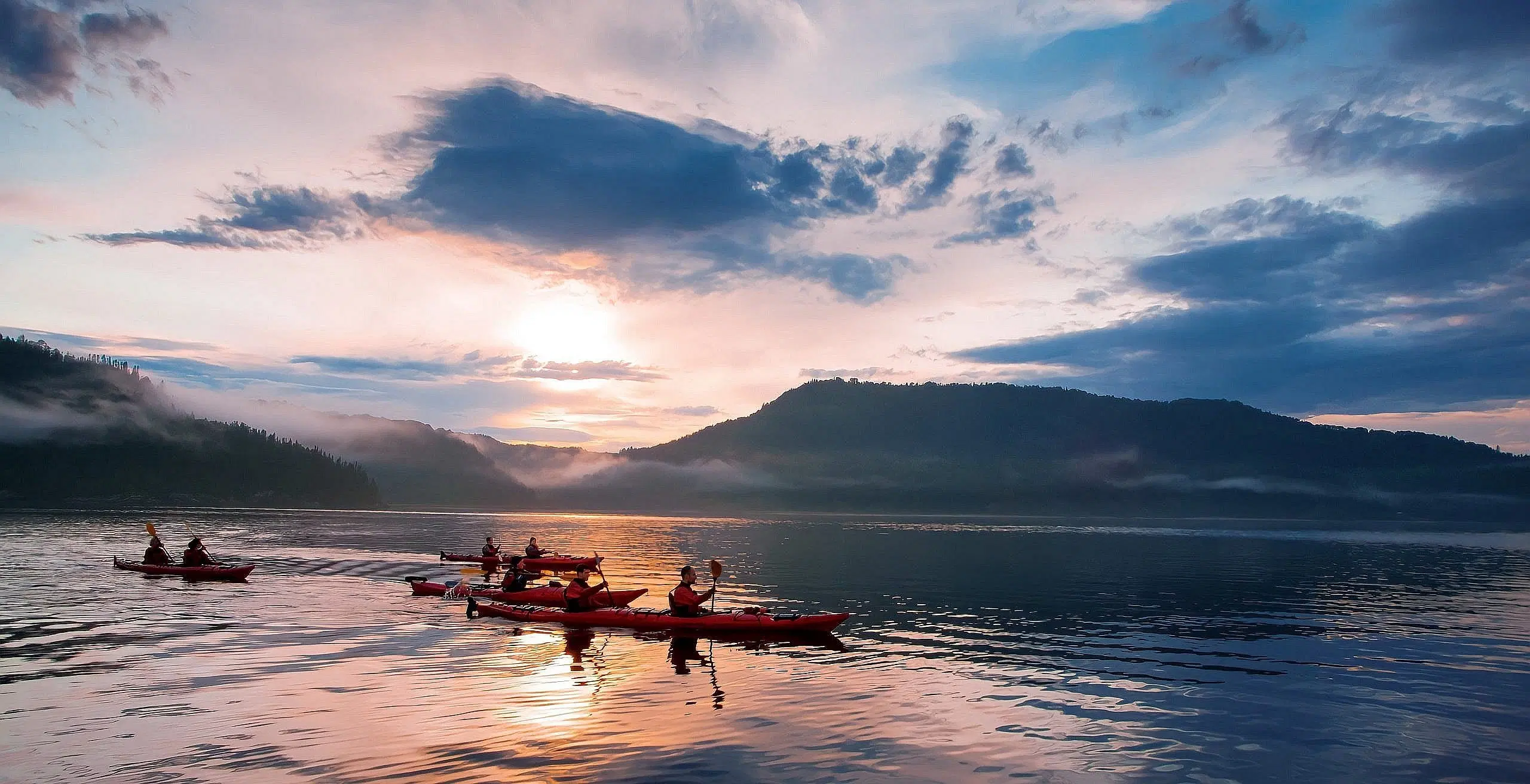
The Bas-Saint-Laurent is a 300-kilometre stretch of coast with a ton of personality: delicious food, surprise wine bars, technicolour sunsets, an artisanal chocolate factory you can sleep in. It’s also easy to miss entirely. I should know—I bypassed it myself maybe 50 times, travelling along the south shore of the St. Lawrence River between Fredericton, where I grew up, and Montreal, where I moved when I was 17. The goal: to get there as soon as possible, and that meant sticking to the Trans-Canada. The St. Lawrence always felt peripheral, and the tiny, remarkable towns that dot along its shores were completely out of sight.
Then I had kids, and the approach to the drive changed: leave early, stop often. A fellow New Brunswick transplant suggested Auberge sur Mer—an inn in the small town of Notre-Dame-du-Portage, south of Rivière-du-Loup—as a good place to break up the trip. Her happy place, she called it.
The first time we turned off the highway one August afternoon three years ago, I got it. The road—Côte de la Mer—was so steep I felt like we were about to be plunged into the water, which had gone from being out there in the distance somewhere to suddenly right in front of us. We snaked our way down to water level, where neat homes with names like Summer Charm, Island Shelter and Little Swimmers lined either side of the town’s single street.
Notre-Dame-du-Portage became my happy place, too. We swam in a heated outdoor saltwater pool. We had the best pepperoni pizza I’ve ever had (and I’ve had a lot) a few doors down at Pizzeria des Battures. We ate burrata and oysters and scallop ceviche perched over the water at the inn’s restaurant. We walked on the beach, played at riverside playgrounds, and had soft-serve ice cream as the sun set. And we marvelled, all day, at the St. Lawrence—its brilliance, its mood swings, and above all, its immensity.
In fact, its size is still a source of confusion and conversation for my oldest, who is all of four years old. “Look, Mom,” he said this past July. “The sea!” His little pant legs were rolled up, and his blond hair was all crusty and windswept from the salty air. His tiny toes were digging into the muddy sand. He was so delighted, so enchanted. So confident. I hated to burst his bubble.
“It’s beautiful, isn’t it?” I said. “But it’s a river, remember?”
He was adamant it was not.
And I couldn’t blame him. North of Quebec City, the St. Lawrence really starts to widen, and where we were standing, the word “river” just didn’t cut it, regardless of what a map might have told us. The water in front of us was so vast and relentless. The sky was overcast, and fog had obliterated any sense of horizon, creating a seamless backdrop of grey. So I suggested we call it the fleuve, as in the Fleuve Saint-Laurent. He was appeased—fleuve it is.
Our debate was in keeping with the environment. After all, in the Bas-Saint-Laurent, everything is fleuve-focused. It’s a straightforward philosophy that’s literally signposted in Kamouraska, the region’s southernmost county, where 26 fleuve et détente signs—literally, “river and relaxation”—beckon travellers to kick back and just watch the water.
Over the years, we’ve followed the fleuve up and down Route 132, the scenic highway that runs parallel to the Trans-Canada. It’s taken us from roadside lobster poutine in La Pocatière to a glass of natural Quebec wine on the back patio at Côté Est in Kamouraska to the sunbathing seals and mudflats of Bic National Park to a Nordic shrimp roll served in a squid ink bun with an oyster-mushroom antipasto at the Cantine Côtière in Saint-Fabien. This year, we ended up in the fleuve, on Île Verte, a tiny island a few kilometres off the coast with 28 year-round inhabitants, one small seasonal restaurant and zero ATMs. We booked our motel (a simple five-unit establishment with views of the south shore of the St. Lawrence that’ll knock your socks off) by putting a $50 deposit cheque in the mail a few months ahead of time and crossing our fingers. It was magical.
Since that first summer, a layover in the Bas-Saint-Laurent has become a part of our trip to the East Coast. Now, it’s not a stop—it’s the destination. And we’ll keep coming back. After all, you can’t visit the same fleuve twice
East Point,
PRINCE EDWARD ISLAND
The Pristine Paradise
The eastern tip of P.E.I. is packed with secluded,
tourist-free beaches
BY PHILIP PREVILLE
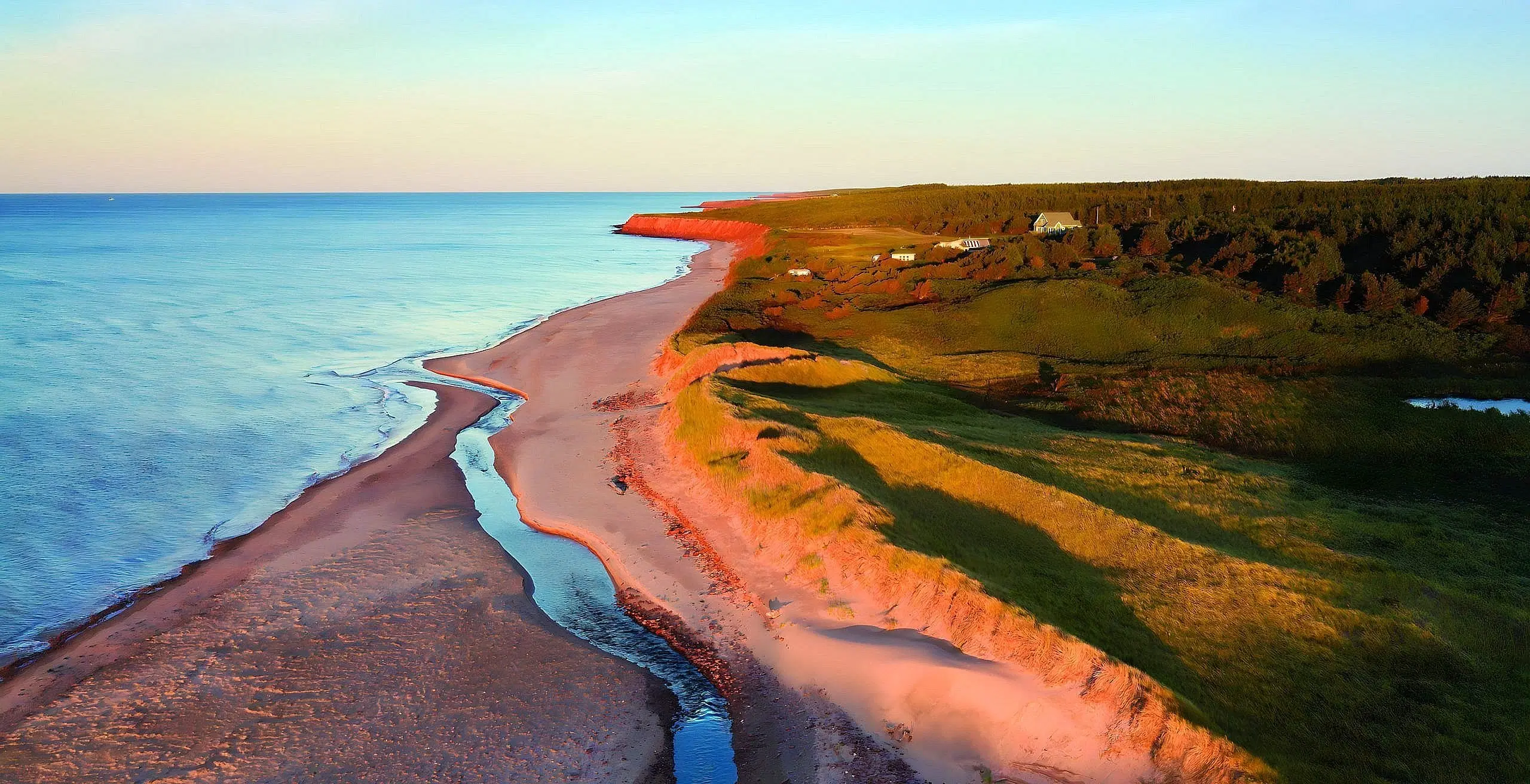
Every summer for the last decade, my family has escaped to a rental cottage in the village of North Lake, a five-minute walk from the local lobster-fishing harbour and a five-minute drive from East Point, P.E.I.’s land’s end. And every morning my wife and I sit on the covered porch in the salty breeze, looking out over the Gulf of St. Lawrence with morning coffee in hand, to plan another lazy day at the beach with the kids.
The question is, always, which beach? There are at least a dozen within a 15-minute drive, some facing the vast expanse of the Gulf, others on the calmer waters of the Northumberland Strait. Most vacationers have to pick one or the other, but in East Point we have access to both. The North Lake wind turbines tell us where to go: from the direction they face and the speed of their churn, we know which beaches will be in the lee. No matter which one we choose, even at the height of tourist season, we’ll have it all to ourselves.
East Point is a place where few live and even fewer visit, which is surprising given its pristine shorelines. The sands are fine and soft underfoot. They slope gently into clear waters. Unlike the crowded central island beaches near Charlottetown and Cavendish, East Point beaches are poorly marked, like guarded secrets. Over the decade of summers we’ve visited, we’ve travelled every road from the highway to the shore in search of gems. On the gulf side, the best beach is so well-hidden it took us years to find: first we drive to the end of Big Pond Road, then walk the hidden trail through the bracken and over the sand dune, where the vista opens up onto a haven of unmanicured beauty, prime hunting grounds for rock crab in the water and seaglass along the shoreline. On the strait side we turn off the highway at Elliot’s General Store in the village of Bothwell and follow the dirt road to a singing-sand paradise.
Even when it’s too cold to swim, there’s lots to keep us entertained. We bring hiking boots and walk the shoreline; where the beach turns to rocky outcrops, we just keep going. East Point’s empty highways make for good cycling, as does the Island’s stretch of the Confederation Trail, which follows the abandoned railway corridor to its terminus at the old station in the village of Elmira, now a railway museum. Outside of lobster season, most fishermen will take you on their boats for a three-hour tour. And East Point features more craft wineries and breweries than any other region of the province.
East Point is the land that franchises forgot. It features exactly zero McDonald’s, Starbucks, or any other fast food outlet, save for the lone Tim Hortons in Souris. In their place are mom-and-pop fish-and-chips joints, like Rick’s in St. Peters Bay or the Boathouse Eatery in North Lake, which remind me of the New England drive-ins I ate at as a kid. If we need a foodie fix we make reservations for the nightly fireworks feast at chef Michael Smith’s Inn at Bay Fortune, a six-course extravaganza that starts with oysters and moves on to mains like Island-raised beef short ribs, always accompanied by vegetables from the inn’s gardens.
But all we really need—all anyone on P.E.I. needs—is fresh seafood. The island is made of it, and the best place to get it, not just in East Point but possibly anywhere in the province, is at the beach boardwalk in Souris. When we first visited, Souris Beach was a derelict place. In 2014, the town built a boardwalk with space for businesses, including a patio with shared tables for takeout restaurants. The development, whose total public investment cost less than a house in Toronto, has turned Souris Beach into a regional tourist hub, with businesses selling seaglass crafts, local art, ice cream, poké bowls and more. Sea kayaks and bicycles are available for rent.
The boardwalk’s first tenant remains its best. The Lobster Shack is the simplest of restaurants, simpler than even a greasy spoon. There are essentially six items on the menu: steamed lobster, steamed mussels, steamed clams, raw oysters, a lobster roll and, for fussy kids and vegetarians, a grilled cheese sandwich. No fish and chips, no burgers, not a single fried shrimp. Just the freshest local stuff, all pulled from the water within sight of the boardwalk and cooked without pretense or fanfare. Eating there always makes me think of the French for seafood, fruit de mer. Fruit of the sea. It’s that good.
Sechelt,
BRITISH COLUMBIA
The Laid-Back Getaway
Sechelt offers the best of B.C.’s Sunshine Coast—with a touch of hippie charm
BY SARA HAROWITZ
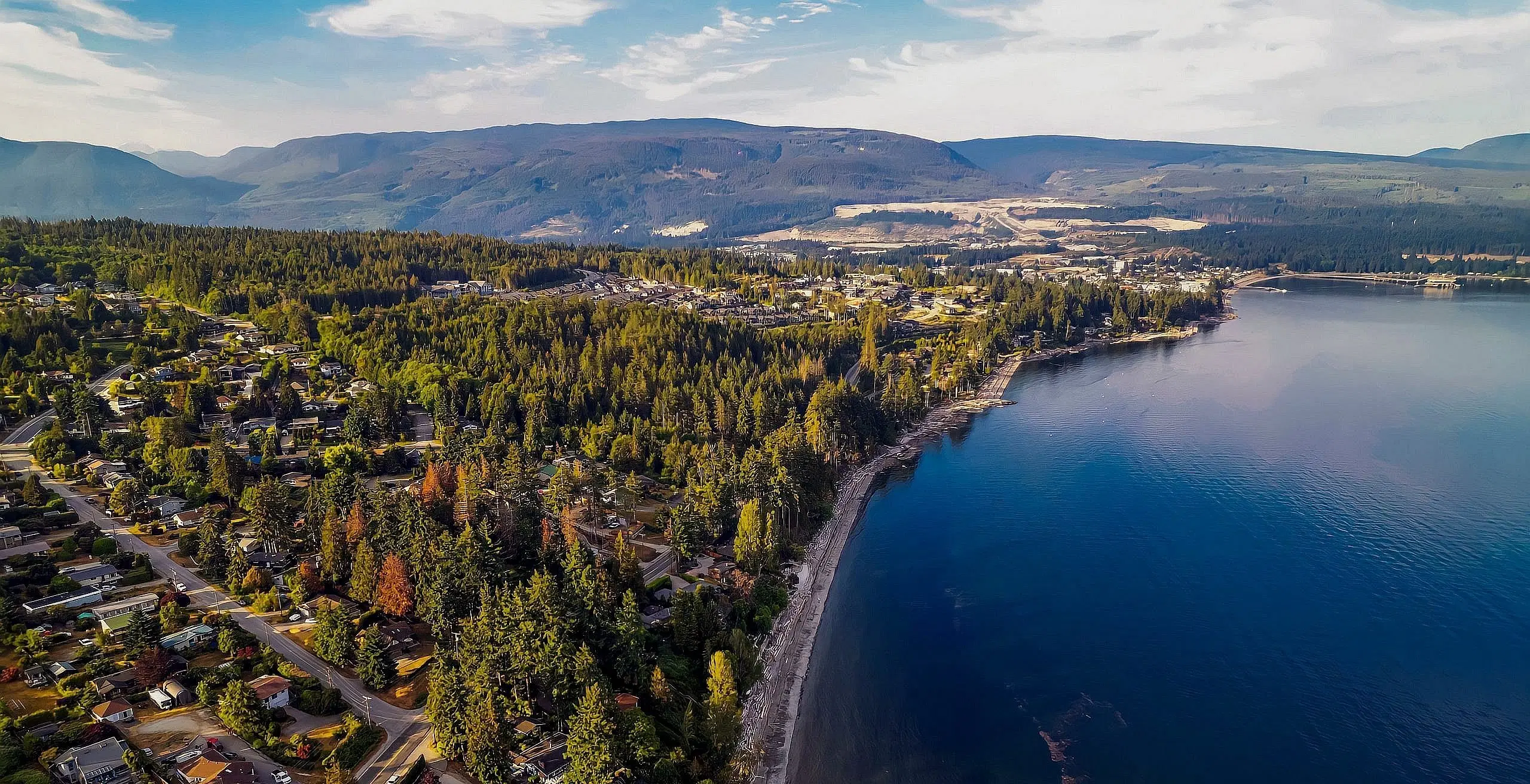
A little over a year ago, my older brother moved from Vancouver to Sechelt, part of British Columbia’s quiet Sunshine Coast, with his wife and two young kids. At first I was sad; after all, my niece and nephew would no longer be just a 15-minute drive away. But then I saw the bright side: I had basically landed myself a vacation home on a slice of British Columbia that everyone is scrambling to see.
The Sunshine Coast is quintessential beautiful B.C.: think expansive sandy beaches; hypnotizingly blue ocean that looks like a painting; lush forests of towering evergreens, leafy ferns and squishy moss. And yet the region has its own identity, with a distinct island feel. It’s laid-back yet still pulsing, with a healthy dose of hippie kook.
The entire area runs 180 kilometres along the southern coast of B.C., on the traditional territories of the Tla’amin, Klahoose, shíshálh, Skwxwú7mesh and Homalco nations. The craggy mountains that line the coast make it inaccessible by car, but that’s part of the magic. To get to Sechelt, you can either take a float plane right from Vancouver to town, or hop on a ferry from Horseshoe Bay and then drive 25 minutes from Gibsons. For outdoorsy visitors, Porpoise Bay is an ideal spot for camping: the sites are located in a whispering second-growth forest and sit within walking distance of an idyllic sandy beach with crystal-clear water. Thanks to Porpoise’s position in the bay, the (normally frigid) Pacific is decently warm here—and if the tide’s out, a walk along the sand reveals creamy-white shells, skittish crabs and pools of little squirming fish.
When I visit my brother, we take the kids to Friendship Park, a pebble beach not far from the centre of town. My seven-year-old niece and two-year-old nephew gambol through the frothy waves and navigate seaweed-covered rocks; they’re beach kids through and through, more comfortable without shoes and always happier outside.
For adventurous types, there’s a mountain-bike park called Coast Gravity. This privately owned, 160-acre expanse is known for its trails, with suitable options for beginners, hobbyists and professionals alike. The founder’s daughter, Gracey Hemstreet, grew up riding there and is now one of the sport’s rising stars; she’s already a B.C., Canada, and Junior World Champion, and she’s only 17.
When it comes time to eat, the tropical El Segundo is Sechelt’s trendiest restaurant—it’s done up to look like a tiki bar and serves a fusion menu with items like wasabi-spiked cheesesteak sandwiches and mussels in a miso-sake broth. My favourite place, however, is Saffron, located on the “downtown” strip (as much as a town this small can have a downtown). This spot serves some of the best Indian food found on the coast. The vegetable pakoras are crispy perfection (they come with a sticky-sweet tamarind dipping sauce), while the vindaloo is sweat-inducingly spicy in the best possible way. There’s a selection of B.C. craft beers to wash it all down, plus a pizza menu for kids who can’t handle the curry.
Back down the highway in Gibsons, there’s incredible Lebanese food at Jamjar, the coastal outpost of Vancouver’s beloved restaurant, where it’s impossible to order the wrong thing. If you’re taking the ferry back home, it’s a great place to stop on the way to the terminal—and start plotting your return.
La Côte-Nord,
QUEBEC
The Once-in-a-Lifetime Road Trip
The epic Côte-Nord drive offers up
whales, puffin colonies and lighthouse hotels
BY STÉPHANIE VERGE
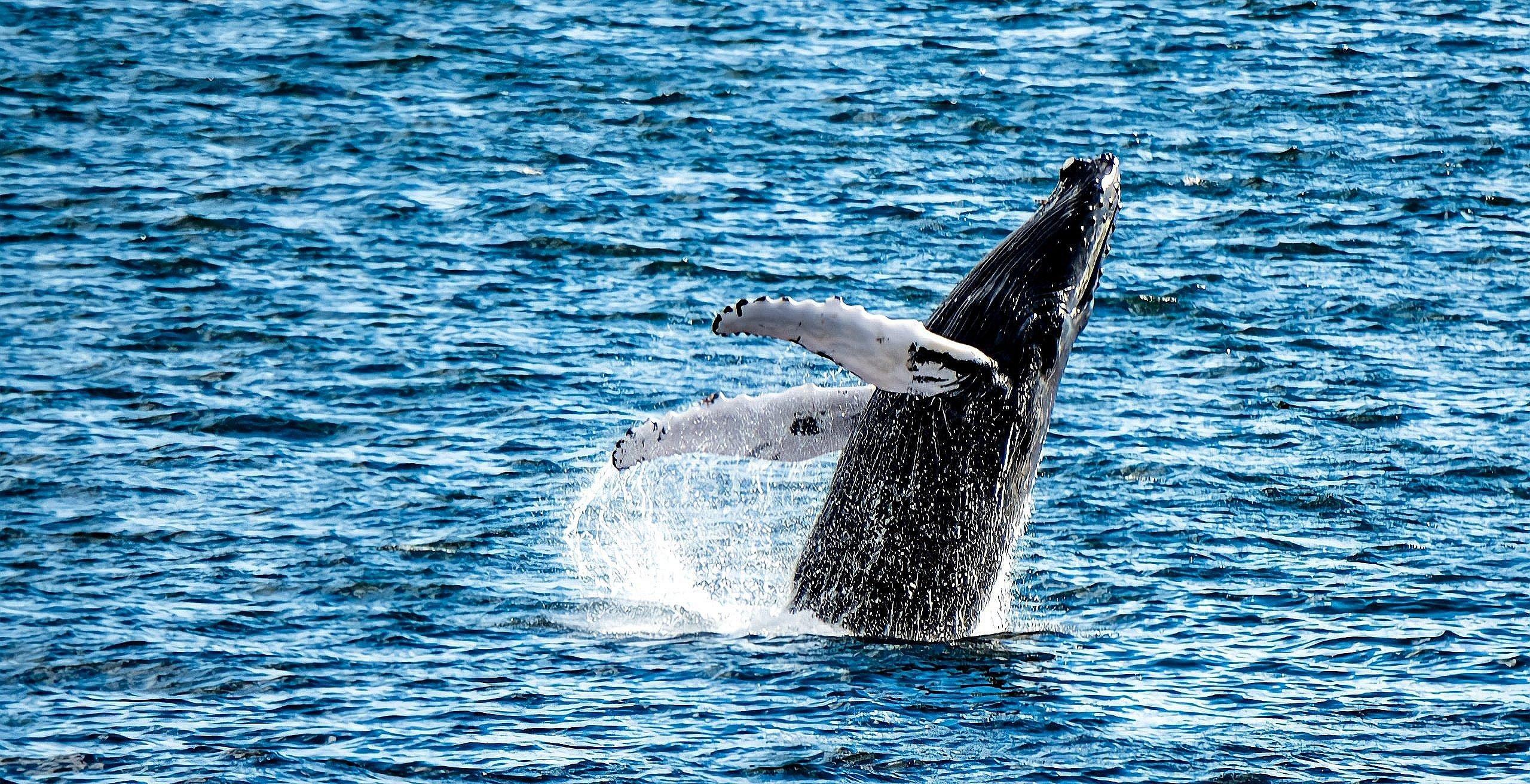
The month I turned 40, I drove 1,319 kilometres from my home in Pointe-Saint-Charles, a neighbourhood in southwest Montreal, to Kegaska, a 124-person community in northern Quebec. At that point, I’d lived in Montreal on and off for a decade; one more year and it would be the place I’d stayed the longest. But most of my adopted province remained, if not unknowable, then certainly unknown to me. I wanted to change that.
The mighty St. Lawrence is the pride of Quebec, and its lifeblood: four out of five residents live by its shores or tributaries. The river bisects the province, so to plan a road trip there is to pick a shore. While the south shore curves into the Gaspé Peninsula to form a shelf over New Brunswick, the north shore goes on and on and on, stretching out and up until it shakes hands with Newfoundland and Labrador. My choice was easy: I would travel through the Côte-Nord region along Route 138, hugging the north shore as the St. Lawrence River turns into an estuary and then a gulf. I gave myself 10 days to get to the end of the road and back; with detours, I’d be driving roughly 300 kilometres a day. I soon learned that the region deserved at least twice that much time.
Five and a half hours from Montreal by car is Tadoussac, the entry point to the Côte-Nord. A small town with a big reputation among whale-watchers, it is the starting point for la route des baleines, which spans the 850 kilometres to Kegaska. Thirteen species swim the St. Lawrence, including acrobatic humpbacks, locally adored belugas and the hard-to-spot blue whales (only 12 or so live in the area). Whale-watching tours depart regularly from towns along the water, but sharp-eyed landlubbers can often catch glimpses of hunting minkes. If you prefer feathers to fins, more than 350 species of birds populate the north shore. In the Pointe-aux-Outardes Nature Park—200 kilometres north of Tadoussac—you can even stay in one of five wooden “nesting houses.” (The tall and narrow “Grand Pic” gives off solid Woody Woodpecker vibes.)
Nearby Baie-Comeau is the headquarters for artisanal soap manufacturer Borale, which draws inspiration from the region’s immense boreal forest (the Côte-Nord’s most significant presence after the St. Lawrence); one sniff of the company’s balsam fir bar is like being catapulted into a Christmas tree. Baie-Comeau is also the town closest to the concrete behemoth known as Manic-2, officially named the Jean-Lesage Generating Station, the first of eight stations that make up the Manic-Outardes hydropower complex. Visitors are left gaping at its gargantuan heft, and suddenly it doesn’t seem quite so absurd that all but six per cent of Quebec’s power comes from hydroelectricity.
My favourite destination is another 50 kilometres up the coast and 20 minutes off-shore by motorboat: l’Île aux Perroquets, nestled in the Mingan Archipelago—both a federal park reserve and the traditional hunting and fishing grounds of the local Innu nation. The minuscule island is home to a lighthouse, a boutique inn and a colony of puffins (the island’s titular “parrot birds”). Picking your way across the rock, even slowly, can take less than an hour—it’s just 800 metres in perimeter. But I easily spent an entire afternoon watching rotund puffins dive into the waves, gobble fish and zoom erratically in and out of their cliffside homes.
Come nightfall, visitors have the option of bedding down in one of nine cozy rooms—six in the former lightkeeper’s house and three in the assistant lightkeeper’s house. The buildings, left derelict for three decades and restored in 2013, offer sweeping views of the gulf. Handiwork from local artisans, including quilts, cups and rugs, adorn sleeping quarters and common areas alike.
Five days after departing Montreal, I rolled into Natashquan, the birthplace of Gilles Vigneault, one of Quebec’s foremost poets and the songwriter behind the province’s unofficial anthem, “Gens du pays.” His hometown, only accessible by boat or plane until 1996, is now the second-to-last stop on Route 138. It’s a destination for fishing, while foragers might opt instead for chicoutai, called shikuteu in Innu-aimun and bakeapples in Newfoundland and Labrador, which grow in the marshy terrain around Natashquan and across the Côte-Nord. This wild golden fruit—it looks like a raspberry—transforms into chicoutai syrups, jellies, teas, vinaigrettes and liqueurs, sold at many roadside stops, most famously at la Maison de la Chicoutai in the village of Rivière-au-Tonnerre.
Kegaska, the final stop on Route 138, is just 50 kilometres from Natashquan. Reaching the end of the road is both an unceremonious and a festive experience—the only indications you’ve arrived are a couple of “no parking” signs; directions to the ferry that will bring travellers further north to what is known as the Basse-Côte-Nord; and a green-and-white panel that reads “138 fin,” plastered with stickers from travellers looking to leave their mark. I held up my phone, snapped a quick pic, got back in the car and started the long drive home.
St. John’s,
NEWFOUNDLAND
The Maritime Glow-Up
A bunch of diverse restaurants and cultural experiences
are shaking up the city’s traditions
BY ALEX CYR
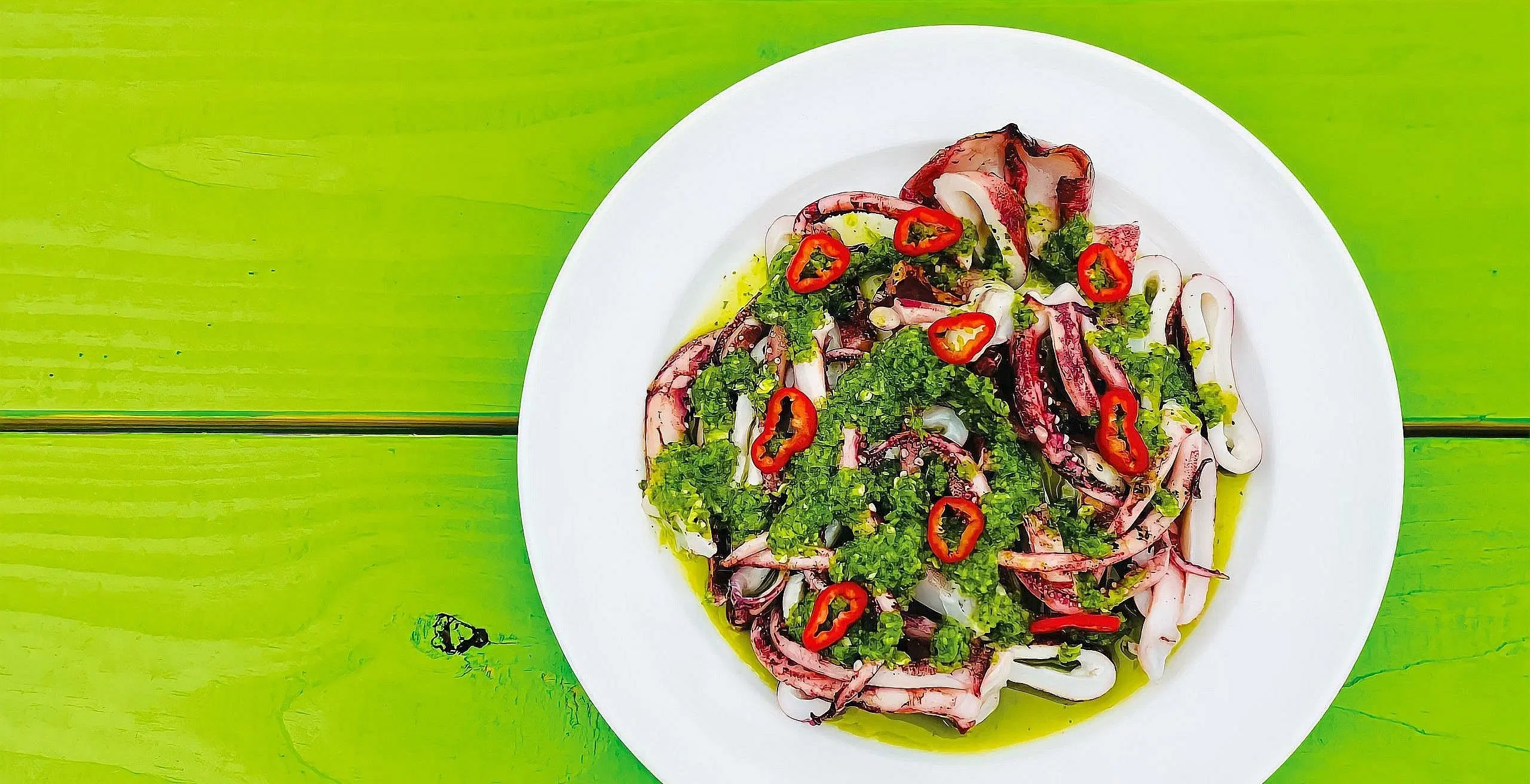
I visited St. John’s when I was 19 with the same itinerary that tourists from everywhere have followed for decades: I hiked to historic Signal Hill, where Guglielmo Marconi received the first trans-Atlantic wireless signal back in 1901. I walked back down to George Street’s watering holes and bar-hopped from O’Reilly’s to the Rob Roy to Trapper John’s with the unmistakable amble of a teenager way out of his drinking league. I capped off the night with a kiss: square on the lips of a cod. I was being screeched in, a local acceptance ritual whose passage transforms a come-from-away into a Newfoundlander, at least for the night. It was a blast.
My trip to Canada’s easternmost capital—however fun and dizzying—was classic, brochure-variety St. John’s: bangers and mash, Quidi Vidi Iceberg beer, sailing and fishing in the Atlantic Ocean. To visit St. John’s in 2014 was not unlike touring it in 1984. The city was a relic of English, Irish and Scottish heritage largely untouched by the heat of Canada’s cultural melting pot.
Nearly a decade later, it’s completely transformed from a frozen-in-amber relic into a vibrant, multicultural hub. It’s become a destination for new Canadians—some 2,500 immigrants came to the province between 2022 and 2023, more than double the yearly average—and a diverse new dining scene has sprung up in response. Newfoundland is the only province in Canada where restaurants can legally shoot and serve game to customers, and the new Thai restaurant Namjim takes full advantage. Its larb salad, a traditional Thai dish, is made with a collection of locally foraged herbs, and its lobster fried rice is a near-perfect symphony of Eastern and Western notes. Meanwhile, Basho on Duckworth Street offers authentic Japanese sushi with local wild-caught seafood. Portage, a fine-dining restaurant on Water Street, merges flavours from both hemispheres in thoughtful dishes like local mushrooms with shawarma schmaltz and steamed local cod wrapped in fig leaves.
No place better blends new and old St. John’s than the Rooms, the province’s largest museum and cultural space. This past summer, an exhibit showcasing a collection of English, Irish and French artifacts and narratives sat in the same building as a presentation of 14 stories of recent immigrant experiences in Newfoundland and Labrador. Just down the hill from the museum is Water Street’s Pedestrian Mall: an outdoor bazaar that opened during the pandemic, flanked with eclectic bars and shops like Boca Tapas Bar, Cojones Tacos and Johnny Ruth, which sources clothes from local designers. And this spring, the new downtown e-bike shop Pedego began offering e-bike rentals—an eco-friendly and active way to shuttle between landmarks like Cape Spear, Signal Hill and Quidi Vidi Village.
All of this may have given the Rock a polish, but those winds of change are no threat to its distinct culture and identity. Its undeniably East Coast customs—like mummering, where people walk the streets in elaborate homemade masks—are alive and well. The Mummers Festival comes roaring back to St. John’s each November, reminding locals and newcomers alike of the timeless power of tradition, community and Atlantic affability.
Windsor,
ONTARIO
The Rust-Belt Revival
This sleepy industrial city has undergone a dazzling
modern makeover
BY JASON McBRIDE
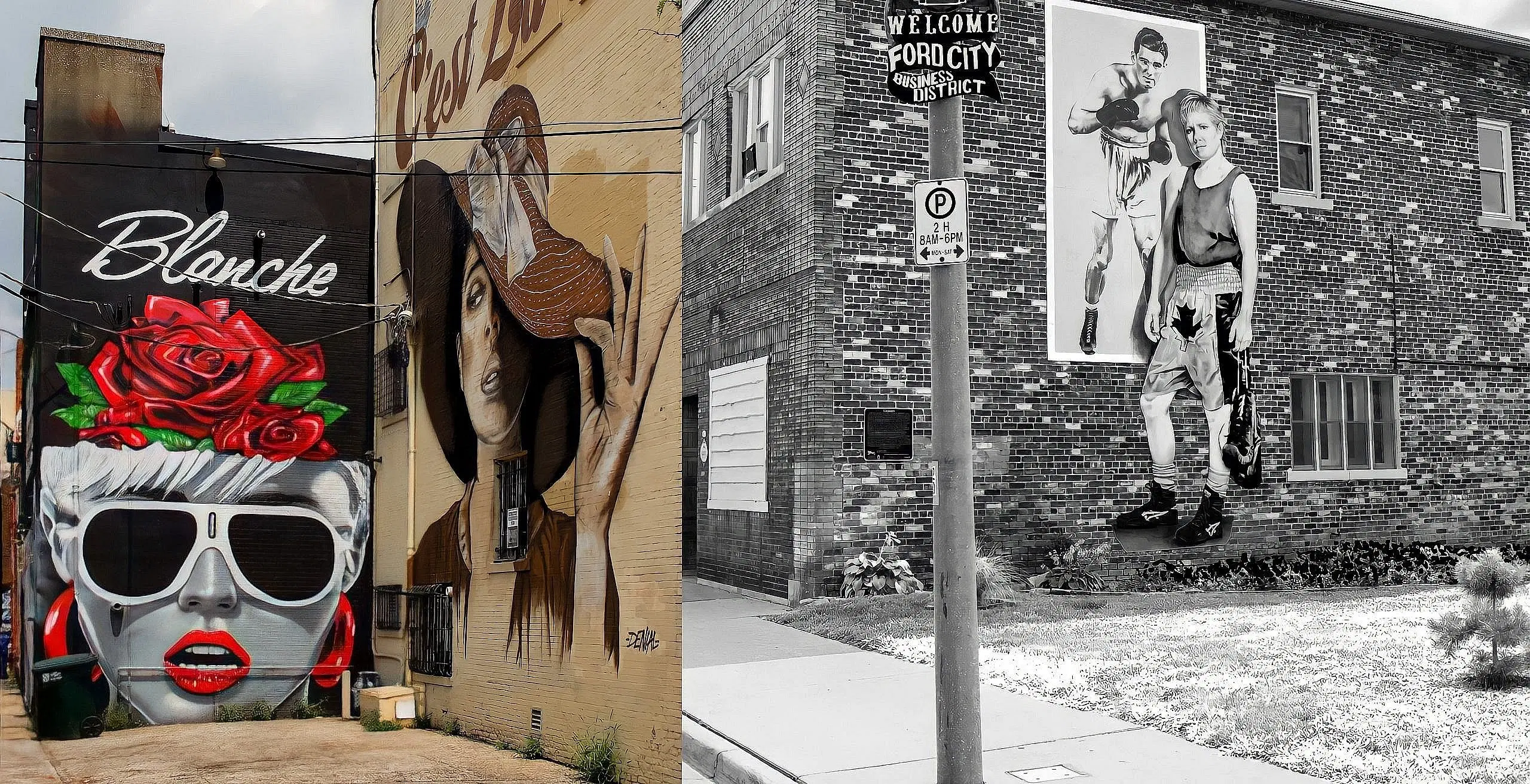
Many years ago, one of my oldest and dearest friends threw a small bachelor’s party for me in Windsor. I had no real attachment to the city other than this friend and his family, but it was cheaper, and arguably less cliché, than going to Vegas or South Beach, or whatever other destinations usually play host to bachelor parties. My initial impressions of Windsor were hazy. It felt like any number of faded Rust Belt towns, any glory it may have had—industrial, economic, cultural—all in the distant past. It was drab, sleepy, uninspiring.
I was wrong. Over the next decade, I visited once or twice a year. And each time I went back, there was more to see and do: Chapter Two, a cute craft brewery; Kenneth Montague’s Position as Desired, a remarkable 2017 exhibition of photos capturing Black identity at Art Windsor-Essex; the Bike Kitchen, a non-profit bike repair shop. All that stuff might have felt ordinary in a city like Toronto or Montreal, but set against Windsor’s backdrop, it heralded fresh possibility. Part of it was certainly my vantage point. I generally hung out in Walkerville, the city’s wealthiest, most walkable enclave, home to a number of charming restaurants, boutiques and Biblioasis, one of the country’s best bookshops and independent publishers. A gentle gentrification was undeniably taking hold, and I watched with surprise and delight as Windsor, at least in certain sections of the city, slowly reinvented itself as a bastion of urbanism.
The tipping point, for me, was the revitalization of Ford City, a neighbourhood a five-minute drive east of Walkerville. Built in the early 1900s as a company town to house and service the thousands of auto workers employed by the Ford Motor Company plant at Drouillard and Riverside, it was once home to several churches, schools and opulent estates. By the mid-1950s, however, after Ford relocated to Oakville, once-bustling Drouillard became a crime-ridden stretch of derelict and vacant buildings. Efforts to revive the area began in the late ’90s with the creation of several vibrant murals that commemorated Ford City’s history, but substantial commercial investment only returned decades later.
We biked to Ford City one evening a couple of years ago to have dinner at the Grand Cantina, a taco joint at the corner of Drouillard and Whelpton (it’s since moved). It was hopping, the food was great and the margaritas were even better. At that point, it was an outlier, but over subsequent visits, other new businesses took root on the strip—a café called Chance Coffee, the full-service bike shop City Cyclery and Michael Difazio Reclaim Artistry, a custom furniture maker that uses salvaged materials. At a birthday party I attended last summer at Pressure Drop, a café and clothing shop, a host of academics, lawyers, activists and city councillors showed up to enjoy cocktails and jerk chicken.
Those same people have been making change across the city. This past April, the Windsor Law Centre for Cities launched the McDougall Street Corridor walking tour, just east of the downtown core. The 25-stop tour, which is accompanied by a richly detailed website, takes visitors through a neighbourhood that used to be home to one of the largest, most dynamic Black communities in Canada. And while Windsor is hardly known for its natural beauty, it will also soon be the site of Ojibway National Urban Park, only the second national urban park built in the country and the first in Ontario to be officially co-managed by First Nations. When complete, in 2025, it will connect and protect nearly 900 acres of oak forest and wetlands, and more than 500 plant and animal species. A massive new electric vehicle battery plant will also open here in 2024, and while not exactly a tourist draw, the investment—and symbolism—is undeniable. At the same time, real estate developers from Toronto have begun to poke around, with the more innovative ones treating Windsor as a kind of laboratory. More thrilling public spaces and architecture could be just around the corner.
A few years ago, people talked about a “Rust Belt Rebound,” with cities like Pittsburgh and Cleveland making a slow comeback, transforming themselves into new tech, academic and arts centres. Windsor’s got a similar momentum and, with luck and more deliberate planning, it will move into a future that’s ever more ambitious and exciting.
Wanuskewin heritage park,
Saskatchewan
The Historic Adventure
The gorgeous prairie grasslands—complete with a herd of bison—offer a glimpse into Canada’s past
BY ASHLYN GEORGE
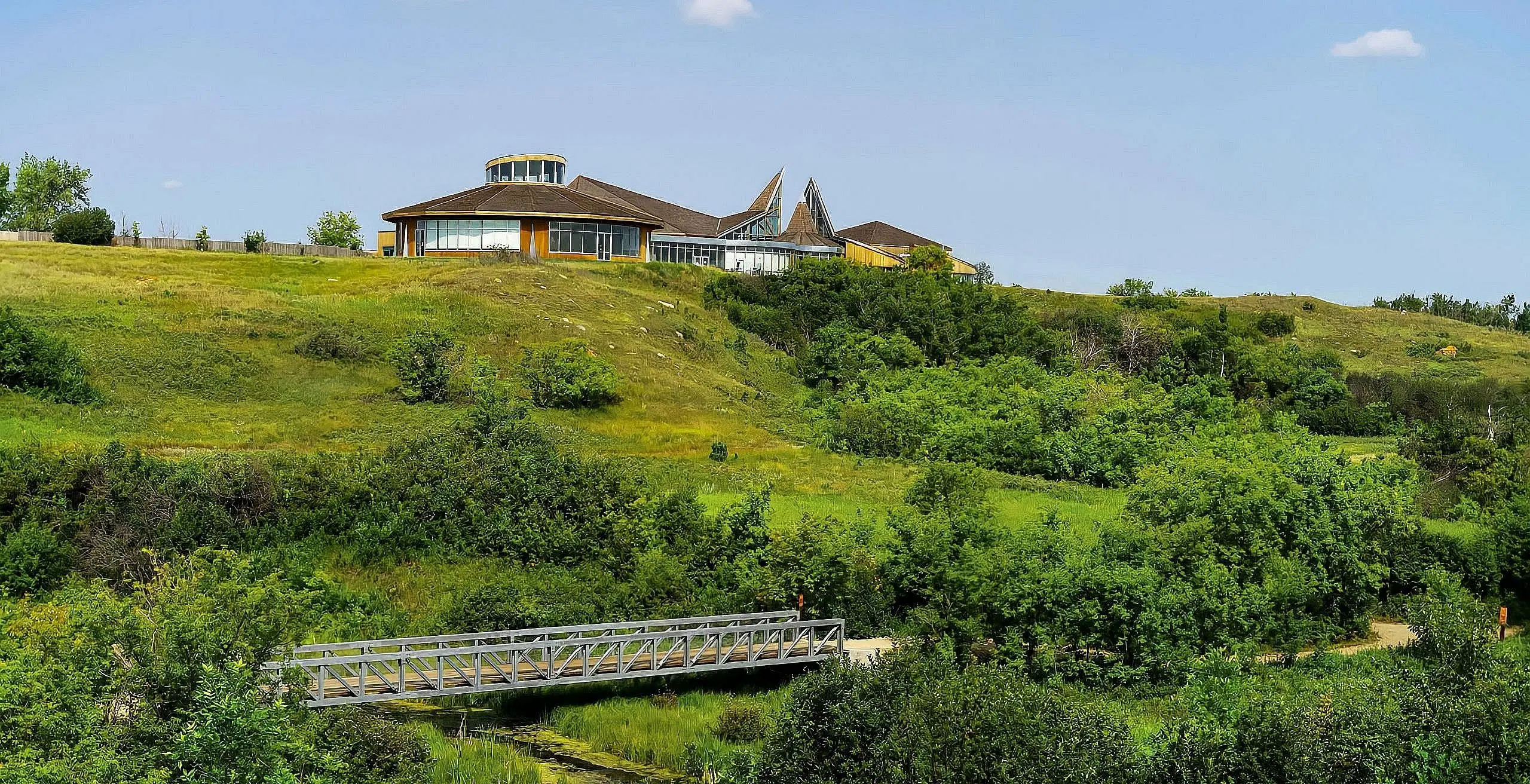
For more than six millennia, the thunderous hoofbeats of 30 million bison echoed across the Great Plains, drumming their presence into the land. Bison, the largest mammals in North America, were brought to near extinction by European settlers in the late 1800s. Now, the prairies of Wanuskewin Heritage Park in Saskatchewan offer a chance to see these long-lost beasts on their home turf: in 2019, Wanuskewin brought a herd of plains bison back to their ancestral land. The first six bison were transported from Grasslands National Park in Saskatchewan, and another five, including four pregnant females, came from a rancher in the U.S. Atop the viewing platform, you can see the herd’s dark humps and the smaller forms of this year’s calves winding among their mothers’ legs.
Wanuskewin, which means “seeking peace of mind” in Plains Cree, has been a gathering place and sacred site for 6,400 years. Every cultural group indigenous to the Northern Plains came through here at some point throughout history. I first visited on a Grade 4 field trip. I sat in the amphitheatre watching powwow dancers and drummers. Their intricate footwork moved in sync with the pounding of the drum; the ribbons and feathers of their regalia fluttering half a beat behind the music. At the gift shop, I purchased a small leather pouch necklace and an arrowhead to tuck inside.
The park is a must-visit for history buffs: it’s Canada’s longest-running archaeological site, and the digs are sometimes available for viewing. The team has unearthed countless bison teeth, plus Indigenous bone tools and amulets, which are on display at the cultural centre. Some artifacts on display are older than the pyramids of Giza. In 2020, the team discovered four petroglyphs, or images carved in stone, one depicting a bison with a horned spirit figure in the middle. The park is on the short list to become a UNESCO World Heritage Site, and this new finding has given it a leg up.
Visitors can also take guided tours of the prairie grasslands. On one visit, I walked with interpretive guide Jessie Muhlbach into the Opimihaw Valley, where a creek of the same name flows into the nearby South Saskatchewan River. White-tailed deer and coyotes roam the coulee, and muskrats and beavers tend to their lodges in the shallow water.
Muhlbach showed me how Indigenous people harnessed the healing power of the native plants that grow here: the residue from a trembling aspen, she told me, can be used as a protective sunscreen. We learned more as we travelled from tree to shrub to plant. Stinging nettle, when prepared properly, can stop nosebleeds. Hawthorn berries contain magnesium and calcium. Their spiky thorns were used for fishing hooks and needles.
The park’s seven kilometres of walking trails are home to the relics of teepee rings and the northernmost medicine wheel in the world. On one visit, in an open field behind me, I spotted a rubbing stone, a shopping cart–sized back-scratcher bison once used to scratch and brush off excess fur.
Everywhere I looked, I saw reminders of pre-contact culture, of the people and animals who once lived here. I thought about the little leather pouch and arrowhead I’d bought 25 years ago and stowed away in a memory box at home—my own artifact of this place they call Wanuskewin
Grand Manan,
NEW BRUNSWICK
The East Coast Time Capsule
This island in the Bay of Fundy is an idyll
of lighthouses and lobster
BY MICHAEL LISTA
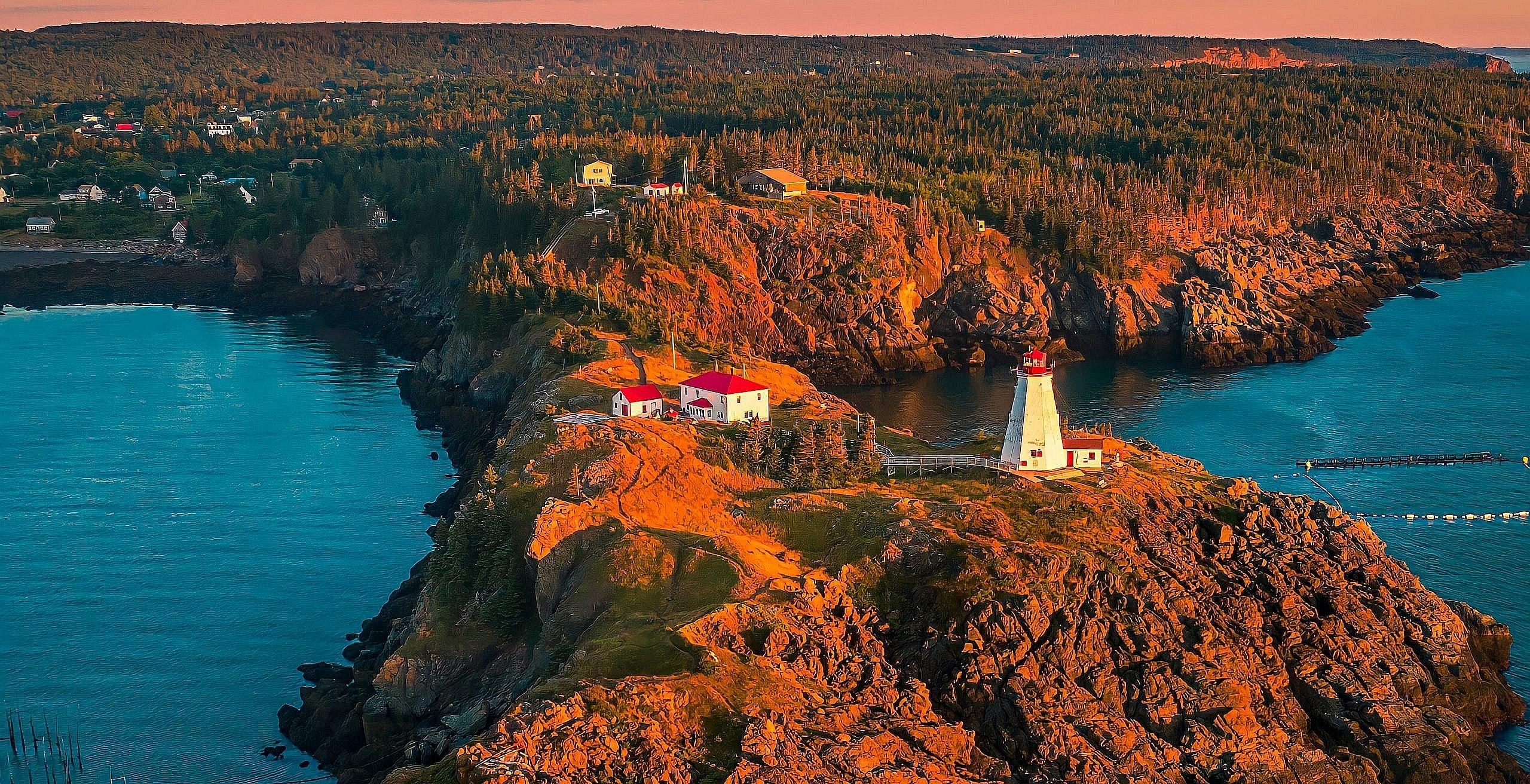
I feel about Grand Manan, the tiny New Brunswick island in the Bay of Fundy, the way Anthony Bourdain felt about each sleepy little jewel of a restaurant whose very anonymity recommended it: I don’t want to ruin it with the fawning publicity it deserves. As far back as the 1950s, a reporter for Maclean’s declared Grand Manan “the island that’s too good to be true.” The island is only accessible by a 90-minute ferry from Blacks Harbour on the mainland, and the enchantment starts on the way over, as minke, finback, humpback and even the notoriously elusive right whales flank the boat. The cliffs above the corrugated sea are high and steep, and the lighthouses stand like the steeples of a church whose congregations lost their faith. But someone still paints them white and red, and someone still maintains the narrow footbridges that lead to them.
Our guide on Grand Manan Island was Peter, a local lobsterman. He took us down to the Seal Cove wharf for what he called a special supper—a surprise. The sky was clearing after rain but the cold was coming in, and the white and blue lobster boats were moored there, rising and falling 20 feet twice a day with the world’s highest tides. Peter had some equipment set up on the floating dock next to one of the ships, the Maliseet No 2. Some prescient seagulls hovered above it all—a propane tank hooked up to a rusty old red gas burner, a pot of seawater coming to a boil upon it, a folding table holding a case of beer, and a huge pipe wrench, the utility of which was still mysterious. Then from the water in front of the prow of the Maliseet No. 2, Peter hauled up a gray plastic crate that looked as big as a coffin. Inside were about two dozen live lobsters, which he’d trapped in the Bay of Fundy that morning. They weren’t like the lobsters you find in your city grocery store or fishmonger, sedated by travel and pacified by captivity; as he dropped each one into the boiling pot, it kicked like a mule and slapped its tail as hard as you can clap your hands. Four of us ate every last one, and did it the local way Peter taught us to—pulling the tail open along its ventral vertical seam the way you’d unbutton a jacket, and bashing open the claws with the pipe wrench. Served without utensils, only a little island-made garlic butter and lots of beer, it was the best meal I’ve had in Canada.
Grand Manan has also had the habit of attracting the affection of some of the continent’s finest fiction writers. The Pulitzer Prize–winning novelist Willa Cather, chronicler of the American West, would retreat to the island almost every summer in order to, as her biographer James Woodress would write, “work there free from civilized distractions.” Cather’s enchanting cottage is still available for rent. Our first and only female Nobel laureate in literature, Alice Munro, wrote about the island in a story named after Grand Manan’s other famous gastronomic delicacy—dulse, the edible seaweed that’s hauled from the bay and dried in the sun. It tastes like a potato chip that’s been incubated by a shrimp. In Munro’s story “Dulse,” a failed poet meets a local man who’s obsessed with Willa Cather.
There’s plenty to do on Grand Manan. If Cather’s place is booked, you can stay at the delightful Island Home Bed & Breakfast, a 30-second walk from the ferry dock, and hike up to the Swallowtail lighthouse, perched above Pettes Cove Beach, which surveys the Atlantic and where, as Munro writes, “The goldenrod and wild aster were in bloom, and Japanese boxwood, a rarity in Ontario, seemed commonplace.” You can drive out to Dark Harbour, speckled with ramshackle beach houses, where, Peter jokes, if you build below the high-water mark, you don’t have to pay property taxes. Locals leave their blue and yellow skiffs, with names like Rippin’ Tides, on the pebbled shore. And you can scoot over to Sunrise Seafoods, which has the best lobster roll in the country, and where an old dog sleeps next to the lobster traps stacked just so. What’s novel about Grand Manan is how much, unlike so many other places in Canada, it hasn’t changed—and how it’s miraculously refreshed by what hasn’t yet been lost.
Ucluelet,
BRITISH COLUMBIA
The Storm-Swept Hideaway
Ucluelet has luxurious food, plenty of pampering and a front-row seat to the Pacific Coast’s gorgeous squalls
BY CELESTE MOURE
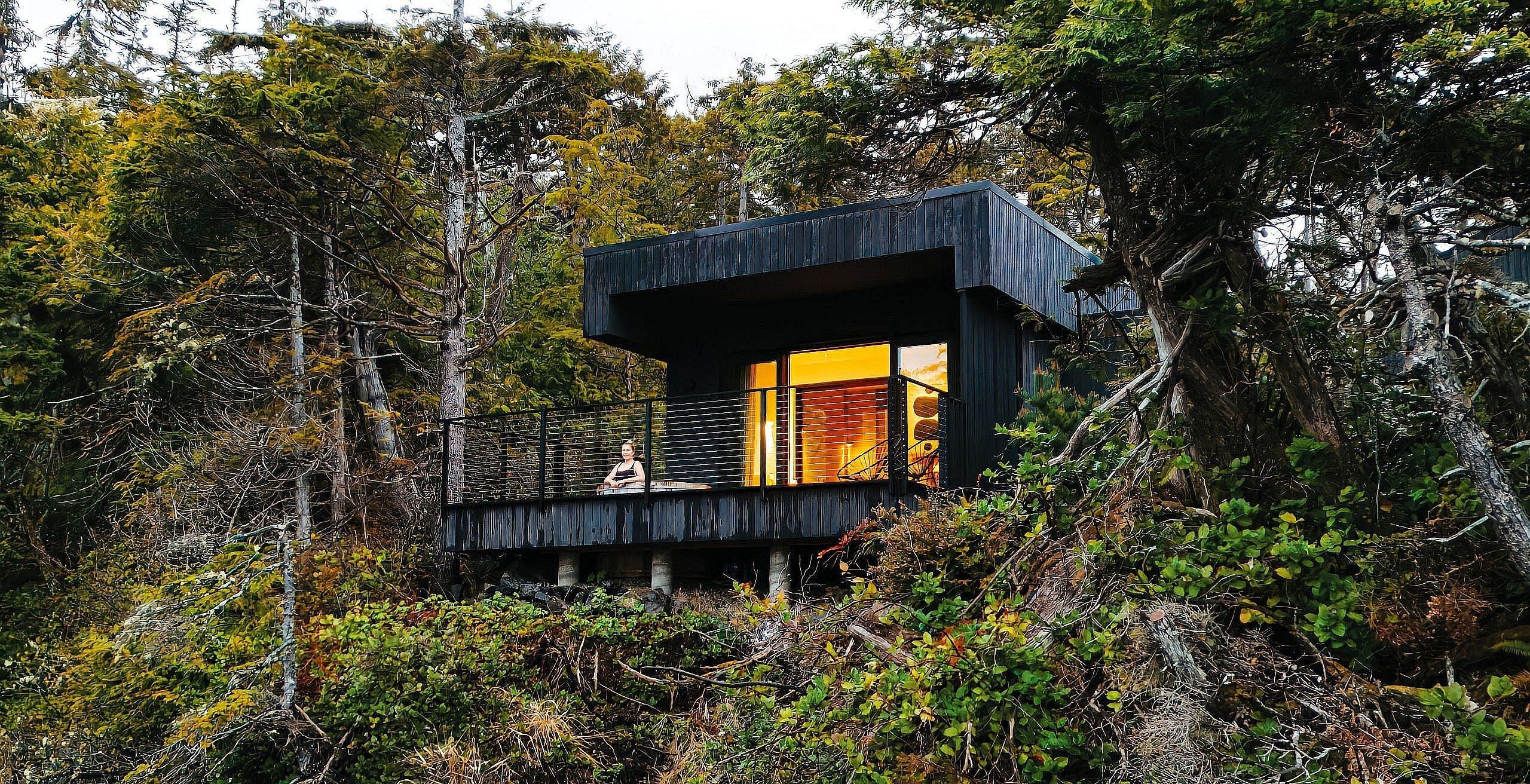
The first time I travelled to the west coast of Vancouver Island, I hoped to experience the one thing that most people who go on an island vacation want to avoid: torrential rain, lots of it. It was storm-watching season, that period between November and March in the Pacific Rim National Reserve when skies bring the drama, waves rise to 20 feet and rain often falls sideways. I returned year after year, and every time I was mesmerized by the miles and miles of beach, the enchanted forests covered in drippy moss and lichen, the angular trees that line the rocky shores, shaped by years of thrashing wind and pounding waves.
In this torrential paradise, Ucluelet—Ukee, if you’re a local—draws adventurous cold-water surfers who come to ride the gnarly waves, kayakers eager to explore the protected Broken Group Islands, hikers attempting the 75-kilometre West Coast Trail and plenty of people looking to do nothing at all.
The last time I visited, I stayed at the Nami Project, a stunning new boutique hotel perched at the edge of the ocean. There are four cabins and four suites, each featuring heated and polished concrete floors and floor-to-ceiling sliding glass doors that open to private decks looking out on a rocky outcrop and the cobalt water beyond. Each cabin has a small dining table set with a Japanese cast-iron teapot and matching cups, with tea blends in the kitchen and all the pots and pans you might need to prepare a simple meal. The bathroom connects to your own private sauna. I spent many hours staring at the sky and sitting with a cup of tea on the deck, listening to the crashing waves.
If you manage to work up enough willpower to leave the cocoon and explore, right out the back door is the Wild Pacific Trail. The trail is the work of Jim Martin, known as “Oyster Jim,” who came up with the idea of carving out a free, public-use walking trail to experience the coastline. Over the decades, Jim and friends expanded the trail to include a loop around the town’s lighthouse and a separate section that connects Big Beach to Rocky Bluffs. Along the way are interpretive signs, lookout points and plenty of benches to catch your breath and take in the views.
Ucluelet also has a pretty little harbour that’s perfect for exploring by kayak; Hello Nature is a local outfitter that will take you there, as well as on multi-day and full-day trips to Clayoquot Sound, Broken Group Islands and Barkley Sound. During a leisurely paddle, I spotted sea otters and seals sunning themselves on the rocks.
Adventuring aside, perhaps the most significant addition to Ukee, and what’s helping to put the town on the map, is Pluvio, an award-winning restaurant (with a four-room bed and breakfast in the back) owned and operated by chef Warren Barr and his partner Lily Verney-Downey. Pluvio offers a seasonal five-course tasting menu paired with some of B.C.’s best wines, as well as an à la carte alternative. The chef makes everything in-house from ingredients he grows on his rooftop, forages from the nearby forests or sources from producers and growers he knows. One of the many highlights during my visit was the spring salmon with homemade wild rose teriyaki, grilled strawberries, dashi, garden nasturtium and charred onion. Every dish was a work of art, building up the anticipation of what might come next. The same is true of the town itself, whether you’re exploring by foot, bike or kayak, or simply sitting by a window watching the storm.
